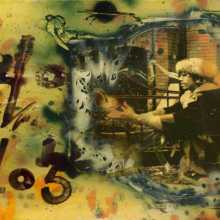
Rammellzee was a seminal figure of the emerging rap and hip-hop movement in New York. A true innovator and polymath, starting out in the late 1970s tagging the A train in Far Rockaway, Queens, where he grew up. He appeared in Charlie Ahearn’s hip-hop film, Wild Style; recorded with K-Rob for Jean Michel Basquiat’s production of Beat Bop; and appeared in the Jim Jarmusch movie Stranger Than Paradise. Despite Rammellzee remaining an elusive figure throughout most of his career, early supporters of his work included French architect Alain-Dominique Gallizia, art dealer Larry Gagosian and James Jebbia, the founder of the streetwear brand Supreme.
Rammellzee had radical theories about graffiti and language as a system of domination to be liberated, arguing that the main purpose of his artwork was to demonstrate his own philosophies. He christened his deconstructed theories ‘Gothic Futurism and Ikonklast Panzerism’, describing the battle between letters and their symbolic warfare against the alphabet’s enforced rules. As Seth Tillett, the NY based theatrical set designer and artist, put it: “Within the depths of the transportation infrastructure that knitted the five boroughs of New York together, Rammellzee hallucinated the alphabet’s military destiny and the annihilation, not just of Graffiti, but of all Roman calligraphy.”
Today Rammellzee’s artwork and music is highly regarded in the Afrofuturist canon. His treatise, Iconic treatise Gothic Futurism, details his anarchic plan to revise the role and deployment of language in society. “The letter is armed to stop all the phony formations, lies, and tricknowlegies placed upon its structure,” he told NY artist critic Joseph Nectvatal in the early 1980s.

